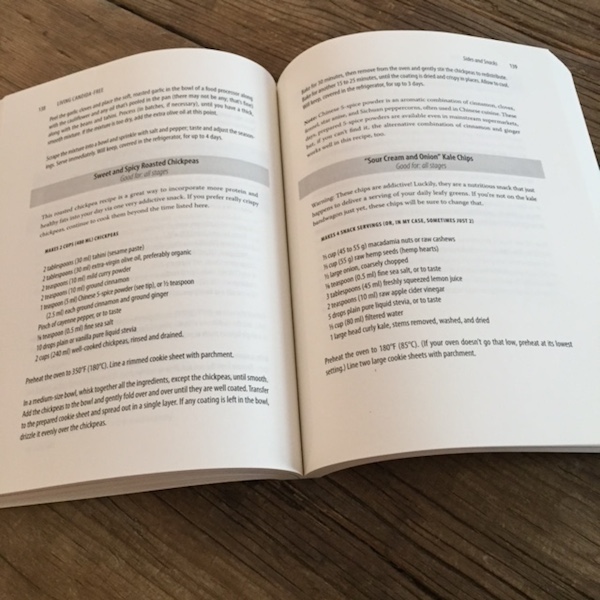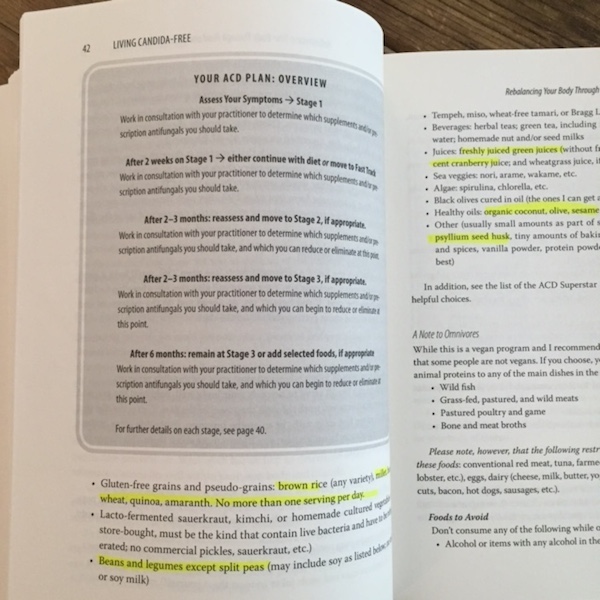As I mentioned on Monday when I featured the single-serve pancakes from Living Candida-Free , I know the author personally and am very impressed with the book.
Just because I consider her a friend doesn’t mean I would automatically think the book is great. It’s always a relief, actually, when that happens! Like when a friend’s baby is not cute… and you say, “Now that’s a baby!” This is a cute baby.
I highly recommend Living Candida-Free for anyone dealing with any of the following health issues: people who eat too much sugar, dealing with yeast infections, IBS, skin rashes, brain fog, or inflammatory issues with their joints. Some of those symptoms describe me, by the way… after reading this book I now realize that at least some of my health opportunities are likely caused by an overgrowth of candida, and I am doing my best to follow her recommendations while still following my other restrictions.

Layout and design:
The book is designed as a health handbook vs. a glossy cookbook, so I will be reviewing it from that perspective. The book is divided into three sections with chapters within each.
Part I: What is candida—and what can I do about it? includes an excellent overview chapter by nutritionist Andrea Nakayama, Cornerstones of the diet, Rebalancing your body through food and lifestyle (The ACD Plan), and Strategies for a successful anti-candida diet.
Part II: The ACD Kitchen includes a kitchen overview, including pantry ingredients and substitutions, and recipe chapters. Recipes are organized as basics, smoothies, breakfast, sides & snacks, soups sandwiches & breads, salads dressings & sauces, mains, and sweets.
Part III: Life after candida suggests lifestyle strategies for preventing a recurrence.
The softcover book is designed using readable fonts, and includes a center insert section of color photographs. My main critique of the book has nothing to do with the content or the author’s excellent work, but has to do with design choices the publisher made within the interior. I found aspects of the book to be difficult to understand, as important items were not brought forward with bold typeface or other ways to highlight text, and if more time had been spent laying out the recipes I am confident that each recipe could have had its own page, or a two-page spread with the book open. I find it difficult to follow a recipe if I have to turn the page in the middle. I hope they correct this in future editions, as it would greatly improve the usability of the book.

Photography:
The nineteen color photographs by Nicole Axworthy, bound in the center, do a lovely job of bringing the food to life. (Just in case you didn’t know, this is how they reduce the cost of printing a book, and it’s perfectly appropriate for a health handbook like this.)

Recipes:
As this diet isn’t too far off what I am already eating, I was able to try some of the recipes, including single-serve pancakes, chard and chickpea soup, grain-free pizza crust, and fresh spicy tomato sauce. Yummy! We especially liked the grain-free pizza crust, which I will be making again with some tweaks. Ricki is insanely creative in her recipe development, and these 100+ recipes will give you plenty of delicious choices while following this plan. I was also intrigued with the mojito smoothie, zucchini fritters, raw carrot cake energy balls, Mexican chocolate sunflower butter, chickpea “quiche”, and emergency fudge. All recipes are gluten-free, sugar-free, and vegan, and nearly all are soy-free. Stevia is the only sweetener.

What I liked about the book:
Incredibly informative, and I especially loved the chapter on strategies for success. I don’t think enough diet and health books address HOW to stay on the diet, they just expect you to read the book, and a magic wand is waved and suddenly you are able to instantly transition over to a big change. Ricki’s warm expertise really shows through in this chapter.
I wasn’t so keen on:
As I mentioned above, the layout issues slightly reduce the usability of the book, but I still highly recommend it. Without nutritional analysis I can’t fully recommend this for low-sodium eaters. Since the recipes include nuts, fermented foods, chocolate, and other migraine triggers, I don’t recommend it for migraine sufferers unless you are 100% familiar with your triggers.
Recommended for:
ACD diet, vegans, vegetarians, celiacs, gluten-free eaters
Not recommended for:
Migraine or low-sodium diets
A note about my cookbook reviews: In the past, I tested at least three recipes from each book, took photos, and described my experience. Due to my dietary limitations (extremely-low-sodium for my Meniere’s Disease and trigger-free foods for migraine relief), it is no longer possible for me to test the recipes and do them justice.
Required FTC disclosure: I received one copy of this book for my use. I will be giving away another copy on February 27th.
Here’s the book if you want to see more:








Thanks for highlighting this book. After doing the Whole30 program, my acupuncturist and I came to the conclusion that much of fatigue was probably candida caused and food-based as Whole30 eating seemed to clear up the fatigue. I am putting this book on my Amazon wish list. I want to learn more.
Anne-Marie, I would definitely recommend you order it! You can still do Whole30, just making a few tweaks. It was enlightening to me, and I’ve read a lot about nutrition lately!
Stephanie, thank you so much for this review! I am thrilled that you actually have found parts of the book to be useful for you (though sounds like this isn’t exactly migraine-friendly)! And I do wish the photos had been placed right next to each recipe. . . but Nicole’s photos are so lovely they stand alone very well. ;-) xoxo Ricki
Yes, extremely useful. It’s always nice if the photos can be alongside a recipe, but I think in this type of book they work very well as a sort of preview for the overall diet… and no deprivation!